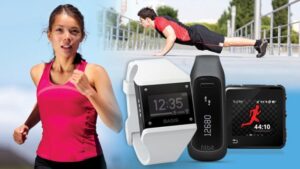
In the fast-paced world of fitness, technology is not just an accessory; it has become a fundamental component of our exercise routines. The rise of tech-enhanced workouts through wearable fitness devices is reshaping how we approach health and fitness in 2024. These innovative gadgets offer a wealth of features that can elevate your workout experience, track progress, and ultimately help you achieve your fitness goals more efficiently. In this article, we’ll explore how wearable fitness devices are transforming the fitness landscape and why they are a game-changer for both casual exercisers and serious athletes.
1. The Evolution of Wearable Fitness Devices
Wearable fitness technology has come a long way since its early days. Initially, devices like pedometers simply counted steps. Today, we have sophisticated smartwatches, fitness trackers, and heart rate monitors that provide a comprehensive view of our health. These devices integrate advanced sensors and algorithms to offer insights into various aspects of fitness, including heart rate, calorie expenditure, sleep quality, and even stress levels.
2. Key Features of Modern Wearable Fitness Devices
a. Advanced Heart Rate Monitoring
Modern fitness wearables use photoplethysmography (PPG) and electrocardiograms (ECG) to monitor heart rate with remarkable accuracy. This allows users to track their heart rate in real-time, ensuring they stay within their target zones for optimal exercise benefits. Enhanced heart rate monitoring also aids in detecting irregularities and potential health issues.
b. GPS Tracking
GPS functionality in wearables is crucial for outdoor enthusiasts and runners. It provides accurate distance, pace, and route data, helping users to analyze their performance and set realistic goals. GPS tracking also helps in creating detailed maps of workout routes, which can be useful for planning future exercises.
c. Sleep and Recovery Insights
Understanding sleep patterns and recovery is essential for improving workout performance. Wearable devices with sleep tracking capabilities analyze sleep stages, duration, and quality. This data helps users optimize their rest periods and make adjustments to their exercise routines based on their recovery status.
d. Activity and Calorie Tracking
Comprehensive activity tracking features allow users to monitor various forms of exercise, from walking and running to cycling and swimming. Calorie tracking helps in managing diet and exercise balance, making it easier to achieve weight loss or muscle gain goals.
e. Stress and Wellness Monitoring
Many modern wearables include features for tracking stress levels and overall wellness. These devices use sensors to monitor physiological indicators such as heart rate variability and galvanic skin response. Managing stress and maintaining mental wellness are crucial components of a balanced fitness regimen.
3. How Wearable Fitness Devices Enhance Workouts
a. Personalized Training Programs
Wearable fitness devices collect vast amounts of data, which can be used to create personalized training programs. By analyzing historical data and workout performance, these devices can suggest customized workout routines that align with your fitness goals and physical condition.
b. Real-Time Feedback and Motivation
Real-time feedback during workouts helps users make immediate adjustments for better results. Features like haptic alerts, audio cues, and visual feedback provide motivation and guidance, ensuring users stay focused and engaged throughout their exercise sessions.
c. Integration with Fitness Apps
Many wearable fitness devices integrate seamlessly with popular fitness apps and platforms. This integration allows users to sync their data, track progress over time, and participate in virtual challenges and communities. This interconnectedness enhances the overall fitness experience and provides additional support and motivation.
d. Monitoring Progress and Achievements
Wearable fitness devices offer detailed analytics and reports on workout performance and progress. Users can track their achievements, set new goals, and review historical data to stay motivated and committed to their fitness journey. Gamification features, such as badges and milestones, further encourage consistent exercise.
4. Choosing the Right Wearable Fitness Device
Selecting the right wearable fitness device involves considering various factors, including:
a. Fitness Goals and Needs
Identify your primary fitness goals and choose a device that aligns with them. Whether you’re focused on cardiovascular health, strength training, or overall wellness, there’s a wearable device tailored to your needs.
b. Budget and Features
Wearable fitness devices come in a range of prices and feature sets. Determine your budget and prioritize the features that are most important to you. Some devices offer basic tracking, while others provide advanced metrics and functionalities.
c. Compatibility and Ecosystem
Ensure that the wearable device you choose is compatible with your smartphone and preferred fitness apps. Integration with other health and wellness tools can enhance the overall effectiveness of the device.
5. The Future of Wearable Fitness Technology
As technology continues to advance, wearable fitness devices are expected to evolve further. Emerging trends include:
a. Enhanced Sensor Technology
Future wearables may incorporate even more advanced sensors, offering deeper insights into various health metrics, such as blood glucose levels and hydration status.
b. Integration with AI and Machine Learning
Artificial intelligence and machine learning will play a significant role in analyzing fitness data and providing more personalized recommendations. These technologies will enable wearables to predict and address potential health issues before they arise.
c. Greater Focus on Wellness
The future of wearable fitness technology will likely emphasize overall wellness, including mental health and stress management. Devices may incorporate new features for holistic health monitoring and support.
Conclusion
Wearable fitness devices are revolutionizing the way we approach exercise and health in 2024. With their advanced features, real-time feedback, and personalized insights, these devices offer unprecedented opportunities for improving fitness and well-being. As technology continues to advance, the potential for wearable fitness devices to enhance our workouts and overall health will only grow. Whether you’re a fitness enthusiast or just starting your journey, investing in a wearable fitness device can provide valuable support and motivation, helping you achieve your health and fitness goals more effectively.



